11th Century Rebec
The Rebec is a descendent of the Rebab, a bowed instrument of the
Middle East in the 9th century. Artistic renderings
of the transitional instruments and the well defined Rebec begin
to appear in the middle to late 11th century.
This is sort of a tangent project for me, as I was not expecting to
start building instruments beyond the Hurdy-Gurdy projects that I
tackled simply to build working machinery. But thanks to Baron
Master Master Pavel Fiddleovitch, the Lawrence Welk of the Steppes, the
Nelson Riddle of the Grimfells, I felt some compulsion to build one of
these instruments. And after completing that one (pictures will
be added later, when I get the rebec and the camera in the same place),
I felt I had to do another one. This is the result.
Several individuals more 'bow savvy' than myself have played this
instrument, and it looks like I have no choice but to build at least 2
more. Because I was not set up to photograph the construction
steps of this instrument (or the First one, for that matter), I will be
adding construction phase photos of the next instrument(s) as I build
them. But that will have to wait, as I am in the process of
building a Citole at this time, and it will take up the better part of
the next few weeks.
One of the most interesting parts of this project was building the
bow. The flat-hair-ribbon bows typical of modern instruments
cause so much buzzing in the instrument that it becomes hard to play
with the action set as low as it should be, and besides, they don't
look right. I looked at several period images, and the standard
high-arched bow seemed to be the answer. Because these bows had
no foot, and only a rudimentary frog, there was no way to hold the hair
in a flat ribbon - it simply stretched as a round skein.
This limits contact with the instrument strings, and reduces the drag
and heavy induced vibration, making the Rebec a little harder to play
and intone, but a lot sweeter sounding.
This Rebec is strung with silver wound strings in the pictures, but I
am re-stringing it with gut to make it even more period sounding.
Here's some pictures and some other info
 Click here
for a sound sample of my rebec. This was a quick recording of an
improvised piece by Pavel's instructor, Nancy.
Click here
for a sound sample of my rebec. This was a quick recording of an
improvised piece by Pavel's instructor, Nancy.
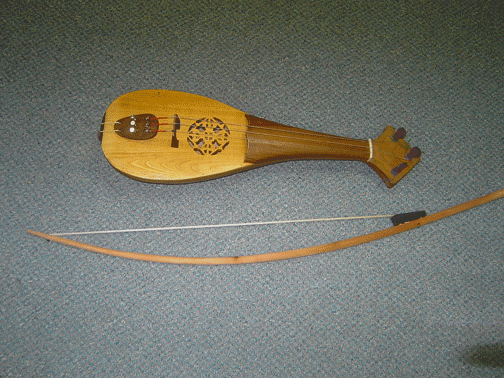 This
is the rebec and it's bow. One of the major differences between
this instrument is the substitution of a rosette instead of the smaller
round soundholes or c-holes at the sides of the soundboard. After
building Pavel's instrument with c-holes, I wanted a more ornate
soundhole, so opted for a rosette so the delicate cutwork would be
somewhat protected under the strings.
This
is the rebec and it's bow. One of the major differences between
this instrument is the substitution of a rosette instead of the smaller
round soundholes or c-holes at the sides of the soundboard. After
building Pavel's instrument with c-holes, I wanted a more ornate
soundhole, so opted for a rosette so the delicate cutwork would be
somewhat protected under the strings.
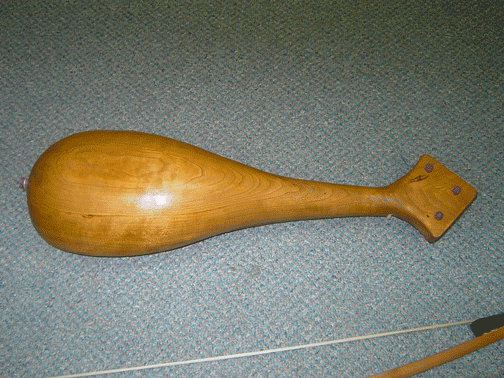
Another view - the
back of the rebec. One of the defining rules of a rebec is that
the instrument (except for the soundboard and fittings) is carved from
a single piece of wood. This instrument was carved from cherry
and hollowed out to form the soundbox. A small piece of ebony was
added at the base of the instrument as a saddle, to take the pressure
of the tailgut and keep it from cutting into the spruce soundboard.
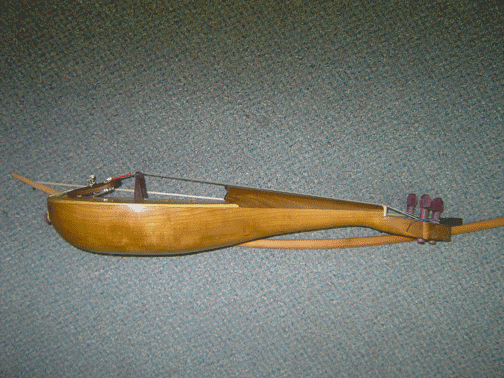
Side view of the
rebec and bow. The tailpiece, bridge, and fingerboard are made of
walnut. The tailpin and tuning pegs are purpleheart. The
nut is antler. The action on this bow is very low and very fast,
but requires using a bow without a lot of contact area.
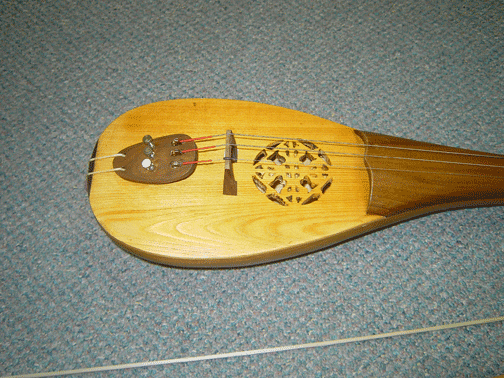
Here is a view of the soundboard, rosette, tailpiece,
and bridge. I installed precision fine-tuners on this tailpiece,
as a convenience. I have a second tailpiece without fine-tuners
for times when more authenticity is needed. The fine-tuners allow
playing for a longer time without the need to constantly mess with the
pegs.
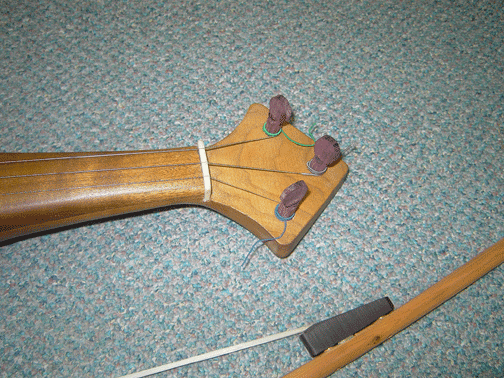
The peghead and purpleheart pegs, along with the nut (and the
frog of the bow). These are temporary pegs, when I find the ebony
that I intend to use for the final pegs I will replace them. The
grain in this piece of cherry is beautiful, and sets off the instument
in every view.
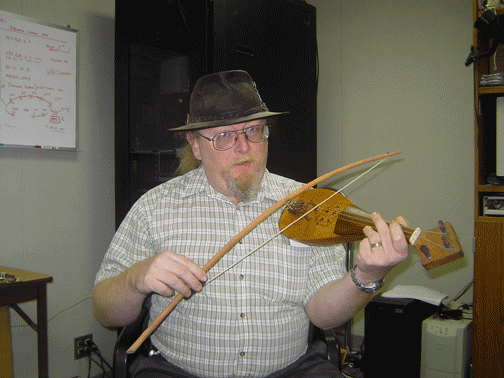 Here
I am with the instrument. It is a lot of fun (though I am just
now getting to where I can play a scale on it with any confidence -
this is my first bowed instrument and I have only had it a little over
a week). It has a very strong tone, and will be louder and speak
more cleanly when I get it strung with gut. The bow was a special
challenge, and while the next one will be done differently, I like the
way this one plays. It is a little tight at rest, but I don't
know that that is a problem, it is just different from what some people
have told me it should be like. But it works, and that's what
counts at this stage of the game.
Here
I am with the instrument. It is a lot of fun (though I am just
now getting to where I can play a scale on it with any confidence -
this is my first bowed instrument and I have only had it a little over
a week). It has a very strong tone, and will be louder and speak
more cleanly when I get it strung with gut. The bow was a special
challenge, and while the next one will be done differently, I like the
way this one plays. It is a little tight at rest, but I don't
know that that is a problem, it is just different from what some people
have told me it should be like. But it works, and that's what
counts at this stage of the game.

 Click here
for a sound sample of my rebec. This was a quick recording of an
improvised piece by Pavel's instructor, Nancy.
Click here
for a sound sample of my rebec. This was a quick recording of an
improvised piece by Pavel's instructor, Nancy. This
is the rebec and it's bow. One of the major differences between
this instrument is the substitution of a rosette instead of the smaller
round soundholes or c-holes at the sides of the soundboard. After
building Pavel's instrument with c-holes, I wanted a more ornate
soundhole, so opted for a rosette so the delicate cutwork would be
somewhat protected under the strings.
This
is the rebec and it's bow. One of the major differences between
this instrument is the substitution of a rosette instead of the smaller
round soundholes or c-holes at the sides of the soundboard. After
building Pavel's instrument with c-holes, I wanted a more ornate
soundhole, so opted for a rosette so the delicate cutwork would be
somewhat protected under the strings.



 Here
I am with the instrument. It is a lot of fun (though I am just
now getting to where I can play a scale on it with any confidence -
this is my first bowed instrument and I have only had it a little over
a week). It has a very strong tone, and will be louder and speak
more cleanly when I get it strung with gut. The bow was a special
challenge, and while the next one will be done differently, I like the
way this one plays. It is a little tight at rest, but I don't
know that that is a problem, it is just different from what some people
have told me it should be like. But it works, and that's what
counts at this stage of the game.
Here
I am with the instrument. It is a lot of fun (though I am just
now getting to where I can play a scale on it with any confidence -
this is my first bowed instrument and I have only had it a little over
a week). It has a very strong tone, and will be louder and speak
more cleanly when I get it strung with gut. The bow was a special
challenge, and while the next one will be done differently, I like the
way this one plays. It is a little tight at rest, but I don't
know that that is a problem, it is just different from what some people
have told me it should be like. But it works, and that's what
counts at this stage of the game.